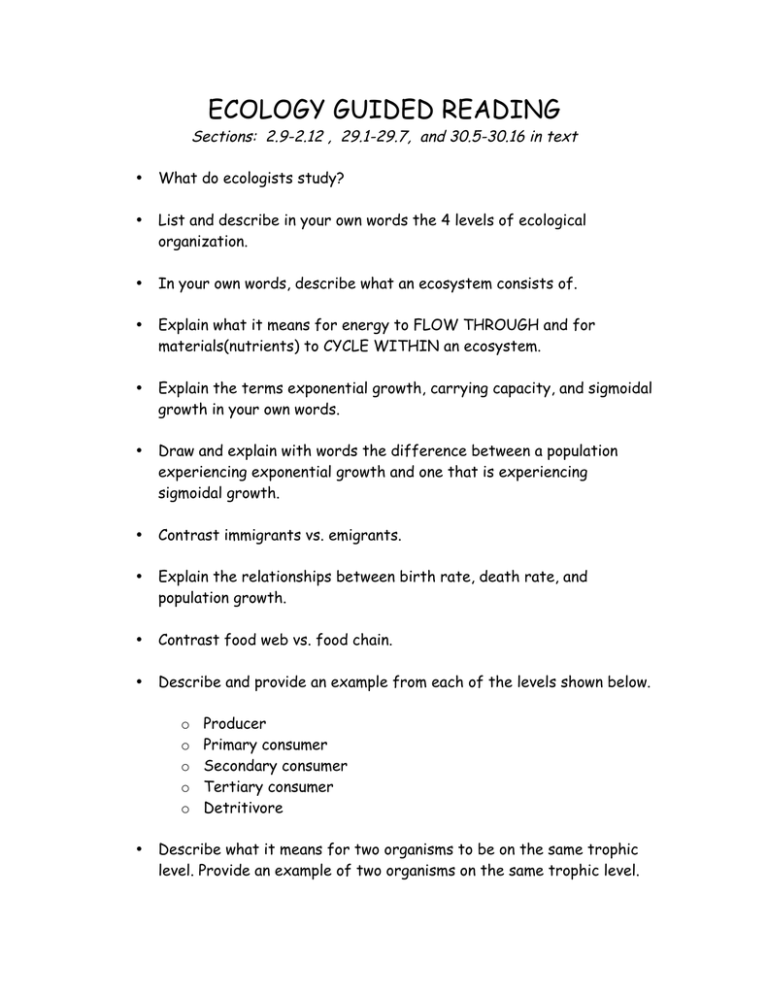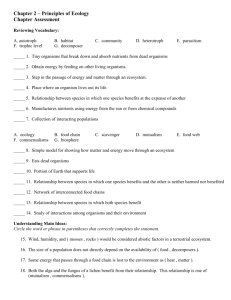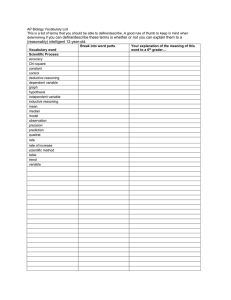ECOLOGY GUIDED READING
advertisement

ECOLOGY GUIDED READING Sections: 2.9-2.12 , 29.1-29.7, and 30.5-30.16 in text • What do ecologists study? • List and describe in your own words the 4 levels of ecological organization. • In your own words, describe what an ecosystem consists of. • Explain what it means for energy to FLOW THROUGH and for materials(nutrients) to CYCLE WITHIN an ecosystem. • Explain the terms exponential growth, carrying capacity, and sigmoidal growth in your own words. • Draw and explain with words the difference between a population experiencing exponential growth and one that is experiencing sigmoidal growth. • Contrast immigrants vs. emigrants. • Explain the relationships between birth rate, death rate, and population growth. • Contrast food web vs. food chain. • Describe and provide an example from each of the levels shown below. o o o o o • Producer Primary consumer Secondary consumer Tertiary consumer Detritivore Describe what it means for two organisms to be on the same trophic level. Provide an example of two organisms on the same trophic level. • Contrast producer, herbivore, carnivore, omnivore, and decomposers(detritivores). • Contrast Gross Primary Productivity, Net Primary Productivity, and Biomass. • In your own words explain what it means for energy to flow through and ecosystem if you haven't done so well above! • Explain why there is usually more members of the lowest trophic levels in an ecosystem than members of the higher trophic levels. Be specific concerning your discussion of energy loss!! • Contrast inter-specific and intra-specific competition. • Compare and contrast Competitive Exclusion with Resource Partitioning. Which one do you feel increases the level of biodiversity in a community? • Contrast density-dependent and density-independent population growth limiting factors. • Contrast commensalist, mutualist, and parasitic symbiotic relationships amongst different species. • Contrast abiotic and biotic environmental factors. • Describe and contrast coevolution and symbiosis. • Contrast mutualism, commensalisms, and parasitism. • Provide and example of mutualism, commensalisms, and parasitism. • How does predation affect competition? Is it ecologically wise to reduce or eliminate the top predators - why or why not? • What defenses have plants developed against their predators? What have herbivores done in response to this? • What defenses have animals developed as inhibition for predators? What have carnivores done in response to this? • Using your own words, explain mimicry. • Contrast batesian and mullerian mimicry. • Study and be able to explain how the birch/willow twig, snowshoe hare, and the Canadian lynx affect each others population levels. A graph may be helpful when explaining this!!







